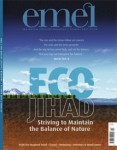
Bone Matters
Issue 85 October 2011
Our bones protect our body; give us shape and structure. Hidden beneath skin and flesh, we often undervalue their importance. Noreen A. Kassem explains how we can take good care of them.
Eating a balanced diet and getting enough exercise in your teens and early 20s is important for overall health and for laying the foundation for healthy bones. Your bones begin to lose strength and density by the time you reach 30 years of age, and healthy nutrition and getting enough physical activity can help maintain bone health.
Osteoporosis is literally translated as “porous bones” and is the most common type of bone disease. It causes your bones to become fragile, weak, and less flexible due to a loss of density in the mineral matrix that makes up your bones. This brittle bone disease does not typically cause symptoms in its early stages and most people are not aware that they have osteoporosis until they suffer a fracture or broken bone. The most common areas affected are the wrists, hips, spine and ankles, and fractures can occur even without injury. Though this disease affects one in two women, the National Osteoporosis Society notes that one in five men over the age of 50 in the UK will also experience a bone fracture due to this disease.
The cause of osteoporosis is not yet fully understood by researchers, but it occurs when your body absorbs too much bone or does not form enough new bone in the normal process of maintaining bone density. Calcium is an important mineral for bone health, but other minerals that make up your bones include phosphate and magnesium. If these nutrients are not sufficiently absorbed from your diet, the bones become brittle and weak. In most cases, bone loss occurs gradually over many years. By the time a fracture occurs, osteoporosis has advanced to a serious stage.
Bone loss is a natural part of aging; we can begin to lose bone mass as early as 25 to 30, when there is more bone loss than bone production. The primary cause for women is the drop in the hormone estrogen during menopause, which leads to almost 30 percent more bone loss. In men, a drop in testosterone due to age has similar effects. There is an increased risk of osteoporosis for women over the age of 50, and men over the age of 70.
A bone mineral density test can measure the extent of bone loss in order to diagnose osteoporosis and your risk of bone fractures. A spinal CT scan can also show bone mineral density. In more serious cases, a fracture or the collapse of spinal bones can be seen in a hip or spine x-ray. Blood and urine tests can help diagnose vitamin D and mineral deficiencies that can increase the risk for osteoporosis.
You can reduce your risk of developing osteoporosis and improve your bone health by lifestyle changes such as eating a daily balanced diet with plenty of fresh vegetables and fruit, and decreasing or eliminating refined foods such as white bread and pastas and foods with excess sugar or salt. Add calcium-rich foods to your diet including leafy green vegetables, low-fat milk, cheese, yoghurt, salmon, sardines with bones, and tofu.
Processed and packaged foods contain empty calories that use up vitamins and minerals in your body. This can lead to a nutrient deficiency that increases the risks of osteoporosis and other diseases. Vitamin D is needed for your body to absorb calcium efficiently. Your doctor may recommend supplements if you are deficient in these nutrients.
Regular physical activity such as walking, jogging, or running, for at least 20 minutes a day, three to four times a week is also important for bone health. Weight bearing exercises in particular, such as lifting light weights and exercise programs such as Pilates and yoga help to build bone and lean muscle strength. It is important to wear supportive footwear and loose, comfortable clothing while exercising.
Other risk factors include:
Menopause, particularly premature menopause before the age of 45
Poor nutrition
Smoking Excess sitting and not getting enough exercise
Being bedridden for any reason A family history of osteoporosis A vitamin D deficiency Chronic bone diseases such as rheumatoid arthritis
Chronic illness such as kidney disease, thyroid disease, liver disease and diabetes
Taking cortico-steroid drugs for any reason, including medical reasons, for longer than six months
Taking anti-seizure drugs Being Caucasian and female, including white, Asian (Indian, Pakistani and Bangladeshi) and Arab ethnic backgrounds
History of hormone treatment for prostate cancer in men or breast cancer in women
Early stages of osteoporosis will not cause symptoms; later signs of osteoporosis include:
Bone fractures due to injuries, trauma or no reason at all
Compression fractures of the spine X-rays that show thinning of bones
Losing height in the past 10 years
Bone pain or tenderness
Lower back pain
Neck pain
Kyphosis or a hunched posture
Bookmark this |
|
Add to DIGG |
|
Add to del.icio.us |
|
Stumble this |
|
Share on Facebook |
|
Share this |
|
Send to a Friend |
|
Link to this |
|
Printer Friendly |
|
Print in plain text |
|


Comments
0 Comments